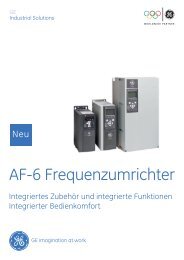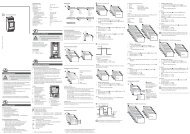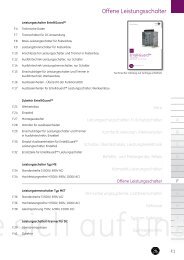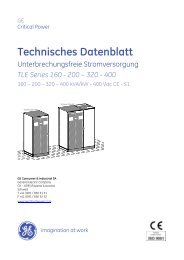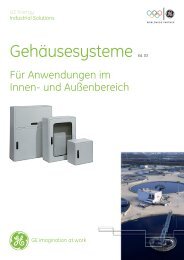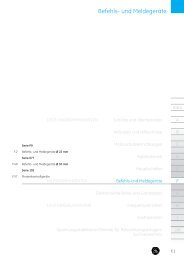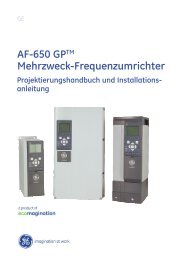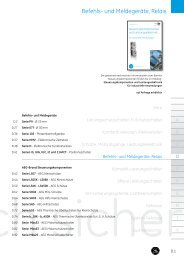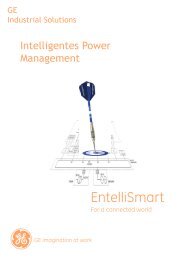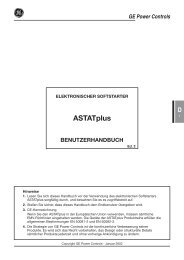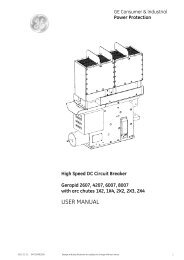High Speed DC Circuit Breaker - G E Power Controls
High Speed DC Circuit Breaker - G E Power Controls
High Speed DC Circuit Breaker - G E Power Controls
You also want an ePaper? Increase the reach of your titles
YUMPU automatically turns print PDFs into web optimized ePapers that Google loves.
7.4 Troubleshooting.<br />
Switching ON is not possible.<br />
A) Closing drive doesn't operate electrically but it is still<br />
possible to close the breaker manually by mean of the<br />
hand lever.<br />
1) Check the supply voltage of the drive (-X2 :1/:2). The<br />
voltage shall not be less than 80% of drive’s rated<br />
voltage.<br />
2) Check the supply voltage of the controls (-X3 :4/:5).<br />
The voltage shall not be less than minimum input<br />
voltage required for installed voltage converter<br />
3) Calculate the voltage drop at both supply lines and<br />
check cables cross section.<br />
4) Check the polarity of the supply connections.<br />
5) Check continuity of the control connections.<br />
Open the control box:<br />
WARNING ! Below operations are done with control<br />
voltage connected. Only trained specialist or GE Service<br />
representative shall execute it. Risk of electric<br />
shock!<br />
6) Check if the PCBs’ plugs are connected and screwed.<br />
7) Check if there is 24V<strong>DC</strong> available at output of the<br />
voltage converter. Check -X10 (:8:9:10) / (:6:7).<br />
8) Check the status of the red LED diode on the SU PCB.<br />
- Does not light – power supply failure;<br />
- Weak light – system ready to CLOSE;<br />
- Intensive red light – system not ready to CLOSE.<br />
Emergency STOP circuit is broken, or NEKO PCB is<br />
not charged, or “anti-pumping” is active for 15 sec.<br />
9) Check if the emergency STOP circuit is not open.<br />
Measure voltage at SU PCB, (-X12 5:/:6). There shall<br />
be ~24V<strong>DC</strong> available for actuation of “closing stop relay”.<br />
If there is no 24V<strong>DC</strong>, check continuity of emergency<br />
STOP circuit. Check relays at ST/UVR/NEKO<br />
PCBs, by controlling state of contacts at points :5/:6<br />
of each.<br />
10) Replace any ST/UVR/NEKO if necessary.<br />
11)<br />
12) Replace the SU control PCB.<br />
13) Switch OFF the power at control box! Check continuity<br />
and resistance of solenoid winding. Replace the<br />
solenoid in case of winding breakage.<br />
Contact GE Service in case the problem is not solved.<br />
B) Closing drive operates electrically, but it is not possible<br />
to keep contacts closed.<br />
Switching OFF is not possible.<br />
WARNING! Below operations are done with control<br />
voltage connected. Only trained specialist or GE Service<br />
representative shall execute it. Risk of electric<br />
shock!<br />
A) Shunt trip does not operate. <strong>Breaker</strong> is able to CLOSE<br />
and OPEN by means of hand lever.<br />
1) Check points A2 to A5.<br />
2) Check the self cut off contact HS11 (-X14 :1/:2).<br />
3) Check the wiring connections and supply line of ST<br />
PCB (-X14 :7/:8).<br />
4) Check the continuity of shunt trip’s coil (-X14 :9/:10).<br />
5) Replace the ST PCB or ST coil if necessary.<br />
Contact GE Service in case of problem is not solved.<br />
B) Zero voltage release does not operate. <strong>Breaker</strong> is<br />
able to CLOSE and OPEN by means of hand lever.<br />
1) Check points A2 to A5.<br />
2) Check point B3 to B5.<br />
3) Check the continuity of UVR’s coil (-X13 :9/:10).<br />
4) Replace the UVR PCB or UVR coil if necessary.<br />
Contact GE Service in case the problem is not solved.<br />
C) ED tripping device does not operate. <strong>Breaker</strong> is able<br />
to CLOSE and OPEN by means of hand lever.<br />
5) Check points A2 to A5.<br />
6) Check the wiring connections and supply line for<br />
NEKO PCB (-X16 :1/:2).<br />
7) Check the voltage level and timing of firing signal for<br />
releasing the C-bank energy (-X16 :3/:4). Voltage signal<br />
shall be between 6-24V<strong>DC</strong> and duration of minimum<br />
3ms.<br />
8) Check if the NEKO is signalling C-bank charging correctly<br />
(-X16 :9/:10). Relays is closed when NEKO is<br />
ready to operate.<br />
9) Check the continuity of ED coil (-X16 :11/:12).<br />
10) Replace the NEKO PCB if necessary.<br />
Contact GE Service in case the problem is not solved.<br />
1) Check the forced tripping release (if installed). Permanently<br />
blocked tripping device, during closing operation,<br />
will effect with mechanism failure and contacts<br />
opening.<br />
2) Check contact system area. Look for any part is stuck<br />
between contacts or into mechanism module.<br />
3) If the zero voltage release is installed in, please check<br />
connection of (–S2) pushbutton. If only NO type (-X2<br />
:6/:7) is used, be sure that (–X2 :8/:9) is shorted.<br />
Open the control box (only when UVR is installed).<br />
4) Check the wiring connections for UVR PCB.<br />
5) Check supply of the UVR control PCB (-X13 :7/:8)<br />
Contact GE Service in case the problem is not solved.<br />
S47183-e 01/2008 Design and specifications are subject to change without notice 53



